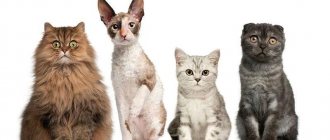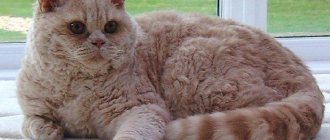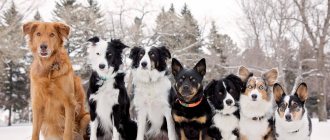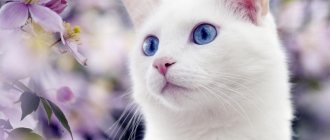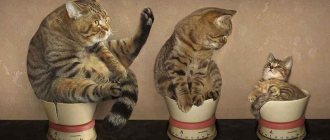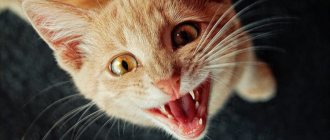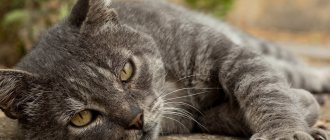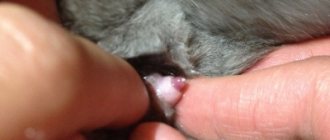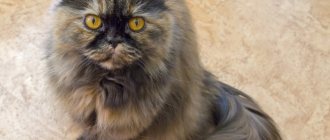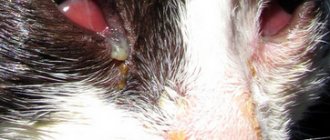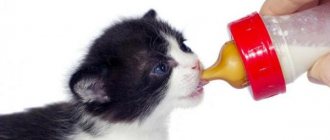The main differences between purebred pets and domestic ones
Scientists have proven that domestic cats have a common ancestor - the steppe cat, which still lives in North Africa . About 200 cat breeds have been registered by felinological organizations. All of them are the result of painstaking work of breeders and have clear standards. The shape of the head, muzzle, eyes, ears, length of fur, limbs, tail, body, color and character are taken into account.
Pedigree cats have documents that confirm their belonging to the breed . They record the names of its three generations and color features. The meaning of an animal's thoroughbred is that when purchasing, the owner will know exactly what character the animal has, what health nuances need to be paid attention to, and how to care for it.
For example , the Siamese cat is known for its loud meowing and vindictiveness, based on this, the future owner knows what he will have to face. Sphynx cats require special skin care and nutritional control due to their excessive appetite.
There are mixed breeds of cats with a whole bunch of genetic pathologies, but at the same time they have an attractive appearance and an easy-going disposition. All this must be taken into account when choosing a kitten - the necessary information can be obtained from the owner of the nursery. This is why experts advise contacting specialized nurseries so as not to literally buy a “pig in a poke.”
If you come across a baby not from a nursery, but, say, it was given to you as a gift, or you picked it up on the street, you can try to determine the breed yourself. To find out what breed a cat is, you need to carefully examine the animal, determine its striking features , and then study the appropriate breed standard.
You can go the simple route and contact a specialist who will tell you how to recognize a cat’s breed and point out its distinctive features. But most often on the streets there are outbred cats that only vaguely resemble their purebred relatives . Such animals often have an elongated muzzle and body, a thin build, medium-length gray, brown, black or tricolor hair, muscular paws with long claws, round eyes, and an energetic tail that expresses the entire range of emotions of the animal. Yard murkas do not exceed 50-75 cm in length and weigh between 2-6 kg.
In fact, purebred aristocrats are not much different from barn cats, so determining the breed by eye often causes difficulties. Most look closely at the external characteristics and compare them using pictures on the Internet.
However, professionals assure that appearance is not the most compelling argument in favor of an animal’s thoroughbred . The cat's habits, character, and temperament are important here. It takes a long time for outdoor cats to get used to the litter box and they don’t realize that they shouldn’t tear up the sofa or nibble on the flowers on the windowsill. Owners have to put a lot of effort into raising their pet and instilling good manners in it. Pedigree cats are another matter! They have the habits of an intellectual at the genetic level.
Google Lens - will help you learn everything about animals
Since 2021, Google Lens has been able to recognize the breeds of cats and dogs and identify other animals. In real time, the artificial intelligence system recognizes objects from the uploaded image and then provides the user with the result.
This application is supported in Google Photos, Google Assistant and on some smartphone models even in a regular camera. Also, Google Leans can be installed from the Android app store.
How can I use it to obtain the necessary information?
- Go to the application and click on the camera button.
- Now either take a snapshot here and now, or download one that's already stored in your gallery.
- After this, you should wait a few seconds and Google Lens will offer you to review the information received.
Now you will see the result, and you will also be able to learn even more about this breed if you start looking for information about it on the Internet. Google Lens also offers not only the name, but also a description of the breed.
How to determine cat breed by size
Pedigree cats are divided into 2 groups based on their body type.:
- Animals with a large, rounded head , a flattened nose and a stocky body. This is the body structure of Persians and exotics.
- Animals with a wedge-shaped head , an elongated and oblong muzzle, a long graceful body and limbs. Angora, Siamese, Balinese, longhair and oriental shorthair cats fit these characteristics.
As for the weight of purebred cats, it varies from 2 to 20 kg . The body length is 40-80 cm.
Big cats
List of giant cats:
- Ashera;
- British;
- Egyptian Mau;
- Kurilian and American bobtails;
- Maine Coon;
- Norwegian Forest Cat;
- pixie bob;
- ragamuffin;
- ragdoll;
- Siberian;
- Turkish van;
- chausie;
- chito;
- Chartreuse.
Asherah
Little cats
List of miniature breeds:
- bambino;
- Dwelf;
- Kinkaloe;
- lambkin;
- munchkin;
- minuet;
- minskin;
- Singapore;
- skookum.
Lambkin
The test is not for weaklings: guess the cat from the photo!
Do you consider yourself a real connoisseur of cat breeds? Prove it to yourself and your friends by sharing your test result!
Write a comment!
I was sure that I understood cats much better! But the test made me tense up
I didn't expect this from myself. It seems like a small thing, but it’s nice.
6 out of 17 I’ll probably go into dog breeding
17 of 17 ... But I still love dogs more, sorry, funny fluffies who are already hungry at five in the morning, and are ready for breakfast at seven in the morning
Surprised. I am a cat lover. I leafed through one book about cats to guess who could become the father of my cat, because... her blue British mother gave birth to 5 completely black kittens. I made a mistake 2 times.
7 out of 17. I thought that I understood cats better - it turns out that I still have to study and study.
How to recognize a cat's breed by external differences
Studying the appearance features will help determine the cat's breed .
Ears
The shape of the ears is a striking distinctive feature indicating belonging to a particular breed.:
- forward-curved ears are characteristic of the Scottish Fold and Highland Fold;
- turned back - only in the American Curl;
- small, low-set, close to the head - in the Highland Fold;
- medium-sized ears, devoid of vegetation with drooping tips - in the Ukrainian Levkoy;
- large, wide at the base, open, with smoothly curving tips - in the elf;
- triangular, pointed, with tassels at the tips - in the Maine Coon;
- hanging ears covered with curls of hair - the poodlecat;
- disproportionately large in relation to the head - in Abyssinians and Orientals.
Short tail
A short tail is a congenital trait that defines the breed:
- American and Kurilian bobtail;
- pixie bob;
- toy bob;
- Kymrik.
Toy Bob
Tailless breeds - Japanese Bobtail and Manx cat.
Reference. Cats of the eastern group of breeds have long and thin tails.
Little paws
In nature, short-legged cats are rare.
All breeds with short limbs were bred artificially:
- bambino;
- Dwelf;
- munchkin;
- minskin;
- Napoleon;
- skookum.
Unique Features
If the pet has any external features, then determining the cat’s breed will not be difficult. For example, these could be:
- Unusual ears. The location of the ears relative to each other, their shape and size often indicate that the cat belongs to a certain breed. Ears tilted forward are a distinctive feature of the Scottish Fold, while ears curved back are a characteristic feature of the Curl.
- Tail. The long, straight tail is typically associated with Siamese, while the broken tail is a distinctive feature of bobtails.
- Paws. Short and disproportionate paws are a sure sign of the Munchkin breed.
Having decided on the breed based on the characteristics of the cat, you need to make sure of the result in other parameters in order to avoid mistakes.
How to recognize a cat's breed by its special coat
The structure of the coat varies greatly among different breeds . Cats are mostly divided into short-haired and long-haired.
Long, thick and straight coat with dense undercoat:
- Angoras;
- Burmese;
- British and Scottish longhair;
- Himalayan;
- Maine Coon;
- Neva Masquerade;
- Norwegian forest;
- Persian;
- ragdoll;
- Siberian;
- Somalia;
- Turkish van.
The Bohemian Rex, Selkirk Rex, Laperm have long and wavy fur
Short with tight curls in the Cornish Rex, Devon Rex and German Rex.
a coarse and curly coat .
Bald breeds:
- bambino;
- Dwelf;
- Don and Canadian sphinxes;
- kohanu;
- minskin;
- Peterbald;
- Ukrainian Levkoy;
- elf.
Reference. Rex cats have pleasant and soft fur, reminiscent of astrakhan fur.
Sphinx
Little ones
Dwelf
Among the representatives of exotic breeds there are also completely small or even tiny cats. For a better understanding of their size and weight, we also present them in the table:
| Breed | Length at withers | Weight |
| Lambkin | From 17 to 20 cm | From 2 to 5 kg |
| Bombino | From 17 to 20 cm | From 2 to 4 kg |
| Skookum | From 22 to 25 cm | From 1.5 to 3 kg |
| Munchkin | Up to 20 cm | From 1.8 to 2.7 kg |
| Dwelf | From 20 to 25 cm | Up to 3.5 kg |
| Singapore | From 18 to 22 cm | Up to 3 kg |
| Minskin | Up to 20 cm | From 2.5 to 3 kg |
Lambkin
Bombino
There are similar differences between male cats and female cats. Cats are larger by several grams, and sometimes even a kilogram. The table shows the minimum and maximum sizes and weights for both genders.
How to find out a cat's breed by coat color
Aristocratic cats compare favorably with ordinary yard cats by their variety of colors . For the latter, it is often simple - tricolor, spotted and striped, one- and two-color.
Breeders worked on the color of purebred cats, achieving interesting colors.
Siamese
The Siamese color or color point is one of the most beautiful and spectacular . It is characterized by dark areas on the animal's face, paws, ears and tail. The body is light in color.
Initially, only Thai and Siamese cats had this color, but as a result of breeding work, the following breeds acquired the Siamese color :
- Balinese;
- Burma;
- Himalayan;
- Neva Masquerade;
- Persian;
- ragdoll;
- snowshoe.
There are several variants of point colors:
- blue point - silver-blue;
- caramel point - gray-beige;
- cream point - beige-amber;
- lilac point - pink-blue;
- red point - rich apricot;
- seal point - delicate cream;
- fan point - pale cream;
- cinnamon point - reddish brown;
- chocolate point - brown chocolate.
Only a specialist can identify point colors . Kittens are born white and the markings appear after a few days.
Blue
The blue color is the same as solid gray, an integral characteristic of the British Shorthair cat . The color is determined immediately at the birth of the babies.
Shades of gray are found in these breeds:
- korat;
- Maine Coon;
- Nibelung;
- oriental;
- Russian blue;
- chartreuse;
- Scottish.
Sand
Sand color or sorel is the least common color and defines the breeds - Abyssinian and Somali cats . The fur is unevenly colored: the main part is bright red (copper), and the tip is ticked (dark, chocolate brown).
Abyssinian cat
Wild
Wild natural color or tabby is characterized by the presence of clear spots, stripes, rosettes , making domestic cats small copies of leopards and cheetahs. This color is observed in the Bengal, Egyptian Mau, Siberian cat, Asherah, Safari, Serengeti, Kurilian bobtail, Ocicat, Caracat, Kanaani. The color is characteristic of hybrid breeds and is determined instantly.
Mackerel tabby color
Brown
Brown or chocolate uniform, monochromatic coat color is typical for cats of royal origin and is almost never found in the wild.
The breeds can boast of this color:
- Abyssinian;
- British;
- Burmese;
- Havana Brown;
- Persian;
- Chantilly Tiffany;
- Scottish.
Habits and character
It is possible to distinguish a cat from a cat by its habits no earlier than seven months.
Until this time, kittens of both sexes are playful, affectionate and their characters differ little.
At puberty, the differences become more pronounced:
- You can distinguish an adult cat from a female cat by its habits: it is lazier and calmer. He sleeps most of the day. Unlike a cat, a cat can be calmly picked up; most often it does not try to break free and run away. This does not mean that he is more affectionate.
Cats love to soak up the sun
Cats are more capricious.
It is worth remembering the famous words that “the cat walks on its own.”
Owners who decide to adopt a female animal should be prepared for the fact that it will be difficult to get along.
Despite the fact that many people think that cats are affectionate and love to cuddle, they do this willingly only during the period of heat.
The rest of the time, the cat will allow itself to be stroked or picked up only out of politeness.
- Behavior during estrus is also a distinctive sign of gender. An adult cat meows a lot during this period, thereby attracting cats. She begins to rub against the furniture and sharpen her claws on it - so you should buy her a scratching post or trim her claws.
- In the first method, the exception is cats that have undergone castration. A castrated cat can be distinguished from a female cat by its more aggressive behavior.
- Cats always mark their territory. This can cause an unpleasant odor in the apartment. To get rid of it, cleaning will have to be done much more often.
- Cats are cleaner. They can lick themselves for several hours in a row. For sleep, cats choose the cleanest and softest place in the apartment. They won't eat from a dirty bowl or drink stale water.
Cats are pickier eaters
If you pay attention to the look, you will notice that in an adult cat it is confident, even slightly arrogant, while in a cat it is wary. You can determine the sex of small kittens of different ages by their eating habits. To do this, you need to put a bowl of milk
If a kitten laps milk and holds its tail up, then it is male, if down, it is female.
I drank some milk!
How to determine the breed of a kitten
It is extremely difficult to independently determine the breed of a kitten , since the distinctive features at this age are poorly expressed. In addition, the characteristics of babies may change as they grow older. For example, fold-eared kittens have erect ears at birth, which droop after a few months.
Experts advise paying attention to the constitution of the body, the structure, length and color of the coat, the color of the iris, and the shape of the ears . If you have a munchkin in front of you, the baby’s legs will be short. If this is a small Canadian Sphynx, then its skin will be bare. And in the Ukrainian Levkoy the whiskers will be curled even with partial presence of hair.
Russian Blues and British Blues are similar in color and coat structure, but have differences in body structure. British cats are heavyset and large, Russian blue cats are more graceful and elongated.
Important! Even if a kitten fully complies with the breed standard, without supporting documents it is considered out of breed.
Head
The structure of the skull and the general appearance of the head are the hallmarks of a purebred cat. It cannot be said that each breed has its own distinct characteristics regarding the skull. To determine the breed by the appearance of the head, it is necessary to study all the values and compare them with the standards adopted for outbred cats.
If the differences are significant, then we can say with a high degree of confidence that the cat has a certain breed . It will be possible to tell what breed the pet is after the cheeks, cheekbones, nose, forehead, profile, bite, chin and nasal pads are assessed.
